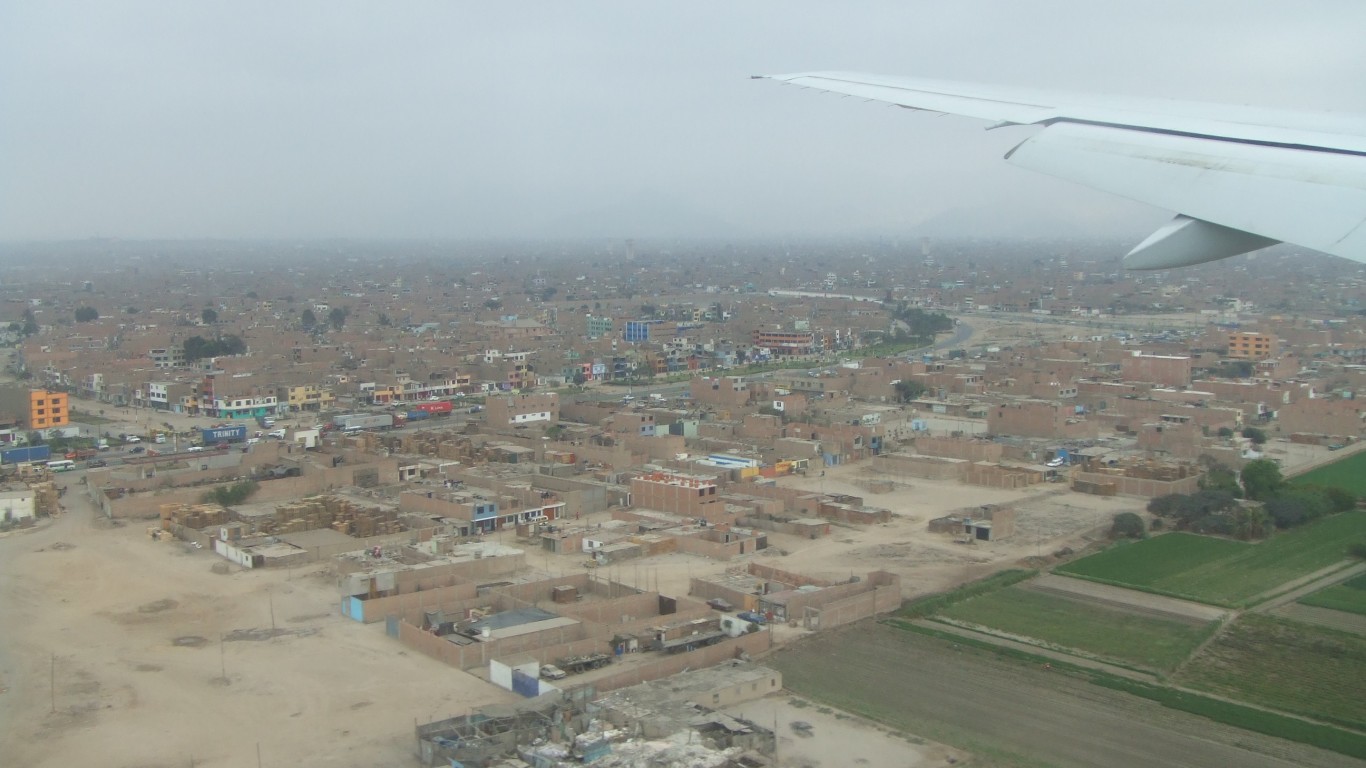
Contaminated water, poor waste management, unregulated industrial pollution, uncontrolled urban sprawl, severe traffic congestion, degraded natural habitats, floods, droughts, and toxic air. These are all common ecological threats among the world’s largest and fastest growing urban areas. But some cities are better equipped to deal with these threats than others.
There are currently 33 megacities — cities with more than 10 million people — in the world, and 14 more cities are projected to become megacities by 2050. Of the 47 projected megacities, high-income cities with low population growth will be better able to deal with ecological threats over the next 50 years. (Also see the 27 countries that face the worst catastrophic ecological threats.)
However, 20 cities with high population growth, low societal resilience, and substantial ecological threats are of most concern – likely to face future sustainability and security issues, according to the global think tank Institute for Economics & Peace report Ecological Threat Report 2022.
24/7 Wall St. reviewed the 20 cities the report identified as high risk – some already megacities and some will become megacities by 2050 (marked by asterisk). The report considered several criteria, including population growth, current coping abilities, number and intensity of ecological threats, ranking on the global peace index (GPI), and various measures of violence. We added estimated GDP for each city in 2020 in U.S. dollars from the international think tank City Mayors.
These 20 cities will be home to an estimated 444 million people by 2050, when the global population is expected by the United Nations to reach 9.8 billion. This means nearly one out of 20 people worldwide will reside in these cities. Meanwhile, continued rising sea levels and temperatures caused by human activities will further worsen many of the problems. (Earth’s CO2 level rose every year since climate change became a national issue.)
Of the 20 cities, mostly in the Global South, 14 urban areas (defined as the city plus the surrounding sprawl) are located in Africa or the Indian Subcontinent. Three of the 20 megacities identified are in Latin America, two in Southeast Asia, and one in the Middle East.
Not all the 20 cities on the list face equally challenging threats. Those facing the harshest challenges are: Kinshasa, Nairobi, Lagos, Dhaka, Baghdad, Lahore, Kolkata, and Delhi. “These cities have high projected population growth rates, poor sanitation, lack of infrastructure, high crime rates and substantial ecological threats,” the report notes.
Poor and potentially fatal ambient indoor and outdoor air quality persists in all but one of the listed 20 megacities. These air quality risks range from moderate to hazardous, which can cause respiratory and other diseases that are significant contributors to morbidity and mortality, according to the World Health Organization.
Ecological and social challenges in many of the world’s megacities are exacerbated by civil unrest, according to the report, the World Bank, and other sources. The instability makes it more difficult for societies and outside organizations to address these ecological challenges. Simply put, the more peaceful a country is, the easier it is to face these problems.
Here are the megacities facing the biggest ecological threats.
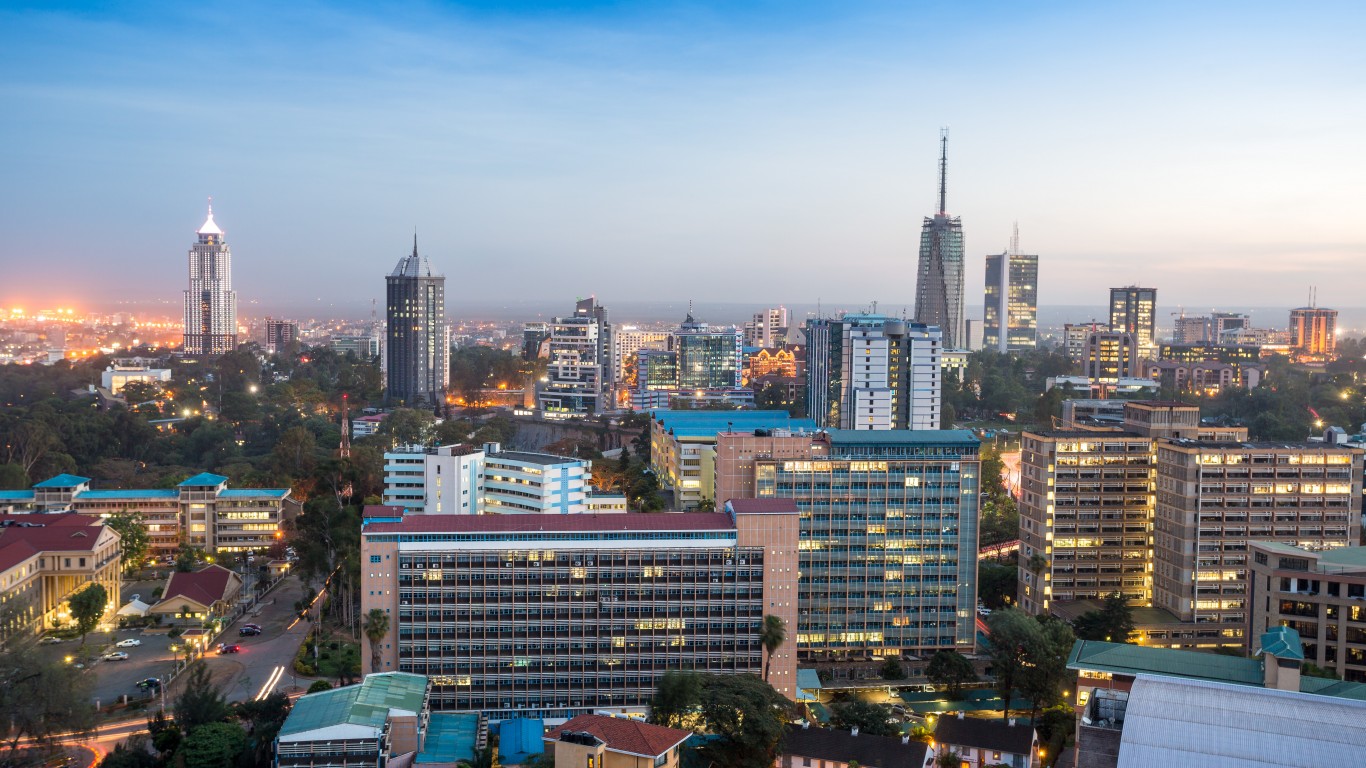
20. Nairobi, Kenya
> Est. population, 2050: 10.4 million, 101% growth from 2022
> Ecological threat level: 5 – Extremely High
> Air quality: 2 – Unhealthy for Sensitive Groups
> Expected climate changes: Drier
> Global peace index (1-5, most to least): 2.79 – Very Low Peace
> Estimated GDP in 2020: $20 billion
Unplanned settlements caused by rapid urbanization and a high degree of poverty makes the Kenyan capital city one of six African megacities on this list most at risk of being unable to deal with profound ecological threats.
Not yet a megacity but projected to be one by 2050, Nairobi has a small population relative to other threatened cities on the continent, namely Lagos and Kinshasa. However, Nairobi’s rapid population growth is outpacing its ability to meet developmental demands, leading to ever-larger unplanned settlements that consume natural areas and generate large amounts of untreated solid waste. As with all of the megacities on this list, an explosion in the number of vehicles is leading to high levels of air pollution.
[in-text-ad]
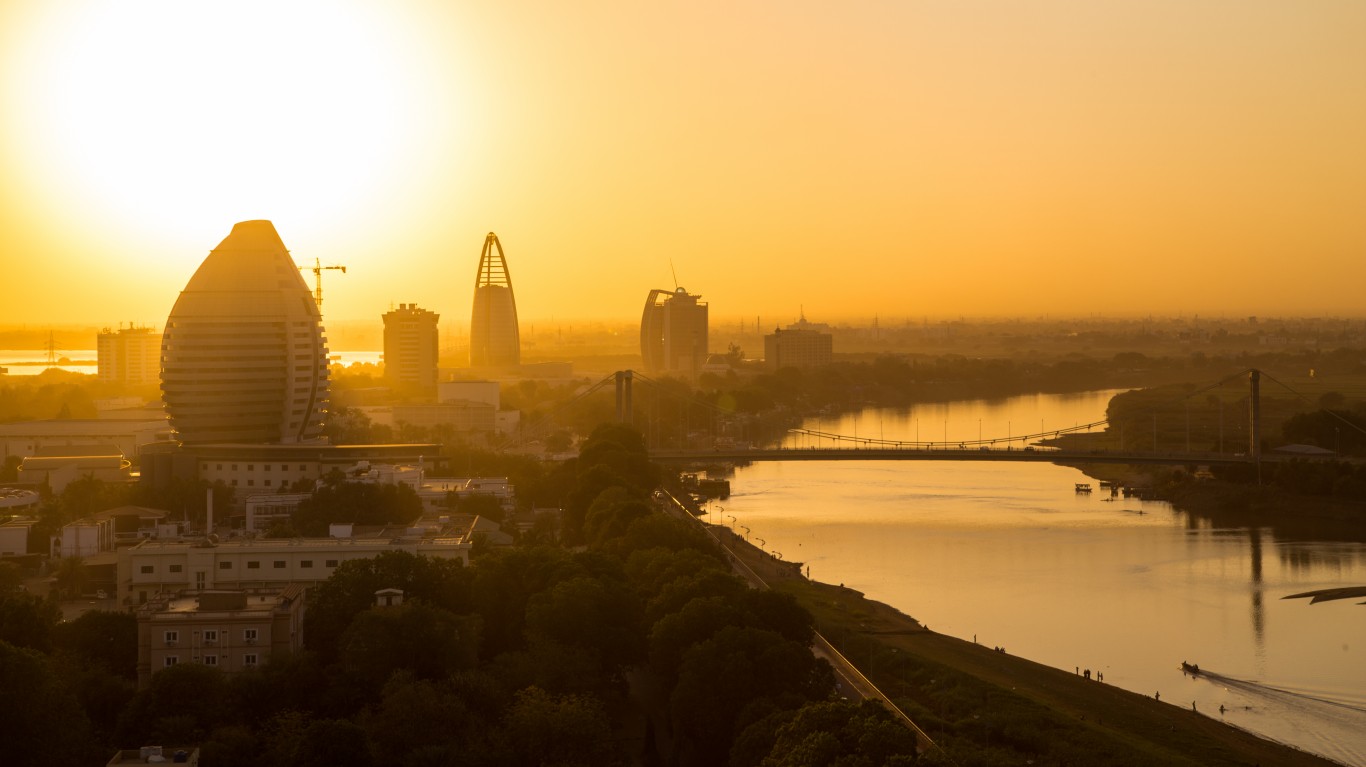
19. Khartoum, Sudan
> Est. population, 2050: 11.2 million, 80% growth from 2022
> Ecological threat level: 5 – Extremely High
> Air quality: 3 – Unhealthy
> Expected climate changes: Hotter, Drier
> Global peace index (1-5, most to least): 3.42 – Very Low Peace
> Estimated GDP in 2020: $51 billion
A 2020 ranking by Notre Dame University’s Global Adaptation Index ranked Sudan as the world’s fifth most vulnerable country to climate change. The arid East African country is hit regularly with intense drought, high temperatures, and torrential rains that cause fast desert flooding.
Civil conflicts over limited land and water resources abound. The country’s capital, centrally situated on the White Nile river, is choked by poor air quality caused by rapid urbanization and a growing fleet of vehicles. The urban area faces serious challenges in solid waste management, too. (Khartoum is not a megacity yet, but is projected to reach that status by 2050.)

18. Baghdad, Iraq
> Est. population, 2050: 13.0 million, 71% growth from 2022
> Ecological threat level: 5 – Extremely High
> Air quality: 2 – Unhealthy for Sensitive Groups
> Expected climate changes: Hotter, Wetter
> Global peace index (1-5, most to least): 3.79 – Very Low Peace
> Estimated GDP in 2020: $39 billion
Water contamination, soil salinization, and the waste produced by years of armed conflict – including but not limited to the U.S. war in Iraq – is wreaking ecological havoc on the country’s capital city as well as the country as a whole.
Air pollution, long caused in part by natural sand storms, is worsened by the city’s growing population and vehicle traffic. Temperatures are rising faster than the global average in Iraq, causing changes to annual rainfall, and testing the limits of Baghdad’s water supply between deluges. (Baghdad is not a megacity yet, but is projected to reach that status by 2050.)
17. Lima, Peru
> Est. population, 2050: 13.4 million, 21% growth from 2022
> Ecological threat level: 5 – Extremely High
> Air quality: 3 – Unhealthy
> Expected climate changes: Hotter, drier
> Global peace index (1-5, most to least): 2.49 – Low Peace
> Estimated GDP in 2020: $123 billion
The arid coastal capital of Peru joins São Paulo and Mexico City as Latin America’s three megacities ranked among the world’s 20 most at risk cities. It routinely has poorer air quality than the other two thanks to the massive amount of traffic.
Drinking water shortages are common, and they are expected to increase as the city gets drier because of global warming. Already, about 1.5 million residents of Metropolitan Lima lack daily access to piped drinking water and sewage.
[in-text-ad-2]
16. Jakarta, Indonesia
> Est. population, 2050: 14.2 million, 28% growth from 2022
> Ecological threat level: 5 – Extremely High
> Air quality: 5 – Hazardous
> Expected climate changes: Wetter
> Global peace index (1-5, most to least): 2.07 – High Peace
> Estimated GDP in 2020: $253 billion
Indonesia’s enormous capital city rests on a delta just above sea level, and often many of its thrash-filled canals rise high enough to touch or top bridges. With 40% of the city already below sea level, Jakarta’s frequent floods are expected to become worse and more frequent. North Jakarta is sinking by 4.9 centimeters per annum.
Fewer than half of city residents have access to piped water as the city never caught up to the rapid urbanization that began in the ’60s and ’70s. As with other megacities in the Global South, Jakarta’s streets are choked with traffic, exacerbating poor air quality. Despite having a high peace level, it is the high ecological threats that place Jakarta among most at risk cities.
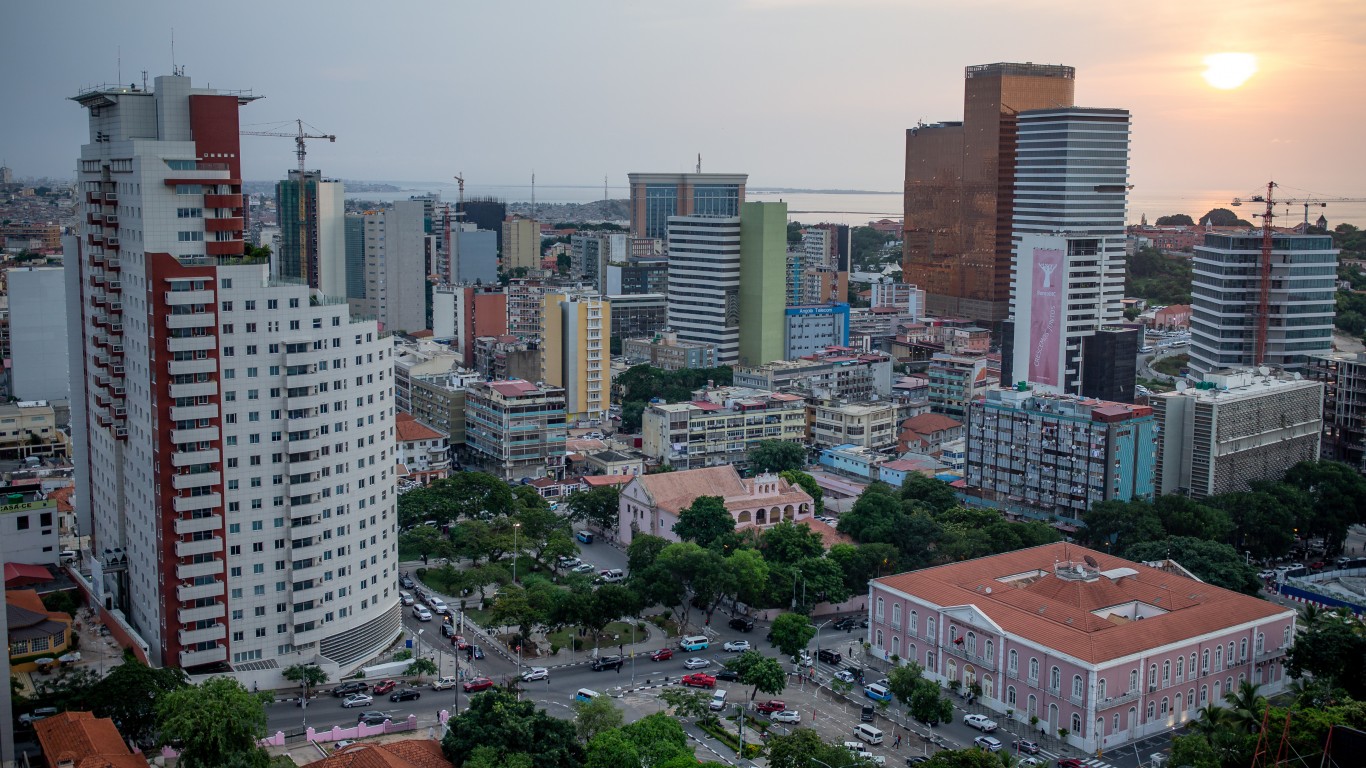
15. Luanda, Angola
> Est. population, 2050: 14.6 million, 62% growth from 2022
> Ecological threat level: 5 – Extremely High
> Air quality: 5 – Hazardous
> Expected climate changes: Wetter
> Global peace index (1-5, most to least): 2.41 – Low Peace
> Estimated GDP in 2020: $29 billion
Oil-rich Angola’s capital city is among six African urban areas facing profound ecological threats amid low peace levels. Luanda is smaller by population than the continent’s largest cities, like Lagos and Kinshasa, but it is encountering a rapid rate of urbanization, especially since the end of Angola’s civil war in 2002, and is projected to become a megacity by 2050. As a coastal city, Luanda is on the front line of rising sea levels. Luanda Bay and Mussulo Lagoon are increasingly polluted, harming important local ecosystems.
[in-text-ad]
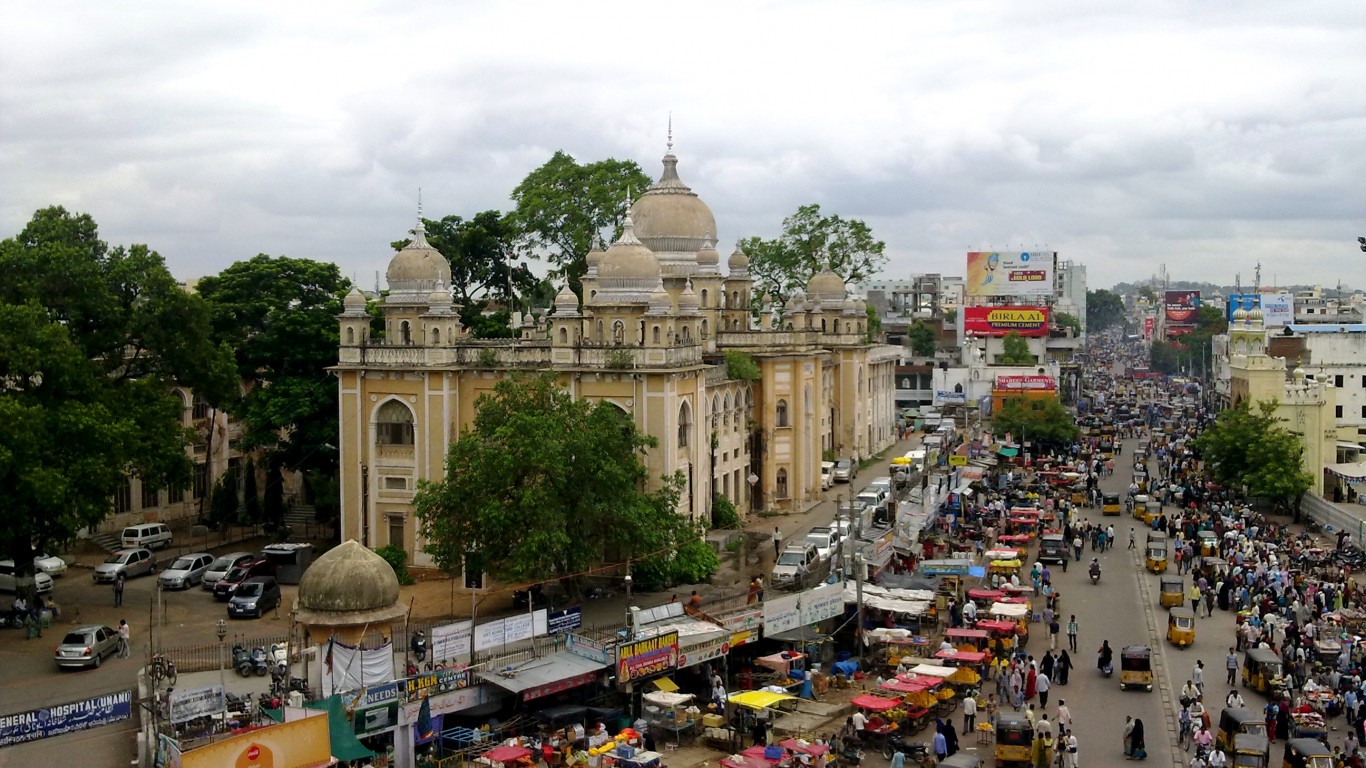
14. Hyderabad, India
> Est. population, 2050: 16.2 million, 54% growth from 2022
> Ecological threat level: 4 – High
> Air quality: 3 – Unhealthy
> Expected climate changes: Wetter, hotter
> Global peace index (1-5, most to least): 2.78 – Very Low Peace
> Estimated GDP in 2020: $92 billion
India’s fourth-largest city by population, located in the south-central region of the subcontinent, suffers from groundwater contamination from its sizable chemical and pharmaceutical industries. Its local lakes receive industrial effluents and untreated sewage. Municipal waste winds up polluting the city’s soils and many of the area’s artificial and natural lakes have dried up.
As with other megacities in the Global South, Hyderabadians inhale harmful pollutants from industrial and vehicle emissions.

13. Dar es Salaam, Tanzania
> Est. population, 2050: 16.4 million, 118% growth from 2022
> Ecological threat level: 5 – Extremely High
> Air quality: 2 – Unhealthy for Sensitive Groups
> Expected climate changes: Wetter
> Global peace index (1-5, most to least): 2.41 – Low Peace
> Estimated GDP in 2020: $13 billion
Dar es Salaam is one of six African cities on this list. Though it is not among the continent’s largest cities, yet, its high population growth poses extreme developmental challenges. Though it is not a megacity yet, it projected to reach that status by 2050.
The urban area’s poor air quality is caused by industrial and residential burning of fossil fuels, and is being exacerbated by a rapid increase in the number of vehicles. Only about 40% of its solid waste is properly collected, and only about 5% of the city’s population is connected to municipal sewage systems, based on 2013 estimates.
12. Chennai, India
> Est. population, 2050: 17.8 million, 54% growth from 2022
> Ecological threat level: 4 – High
> Air quality: 2 – Unhealthy for Sensitive Groups
> Expected climate changes: Wetter
> Global peace index (1-5, most to least): 2.78 – Very Low Peace
> Estimated GDP in 2020: $91 billion
The southeastern coastal city of Chennai is one of five Indian cities on this list. The sixth most populous urban area of the country suffers from industrial water contamination, notably in the Kosasthalaiyar river, a major source of the city’s water supply. Much of the city’s solid waste is not separated, causing its landfills to leach toxins into the soil and underground aquifers. At times, Chennai’s air quality can be worse than Delhi’s notorious smog.
[in-text-ad-2]

11. Lahore, Pakistan
> Est. population, 2050: 21.4 million, 57% growth from 2022
> Ecological threat level: 4 – High
> Air quality: 3 – Unhealthy
> Expected climate changes: Hotter
> Global peace index (1-5, most to least): 3.05 – Very Low Peace
> Estimated GDP in 2020: $67 billion
Lahore is the second largest city and urban area in Pakistan after Karachi. About 12% of the country’s roughly 225 million people live in the urban areas of these two cities. The massive influx of people has far outpaced the country’s ability to meet developmental needs. The amount of hazardous fine particulate matter in the atmosphere, emitted from vehicles, industrial activity, and the burning of wood and trash, routinely exceeds 40 times the World Health Organization’s guidelines, especially during “smog season” in the winter months.

10. Manila, Philippines
> Est. population, 2050: 22.0 million, 52% growth from 2022
> Ecological threat level: 5 – Extremely High
> Air quality: 1 – Moderate
> Expected climate changes: Wetter
> Global peace index (1-5, most to least): 3.05 – Very Low Peace
> Estimated GDP in 2020: $257 billion
Manila is one of two Southeast Asian cities facing the most profound ecological threats from rapid urbanization, large numbers of people living in poverty, deterioration of water quality due to organic pollution, erosion of coastal habitats, overfishing, insufficient industrial and agricultural waste management. Flooding is a regular seasonal occurrence, exacerbated by both climate change and the dumping of solid waste into major waterways, clogging drainage systems.
[in-text-ad]
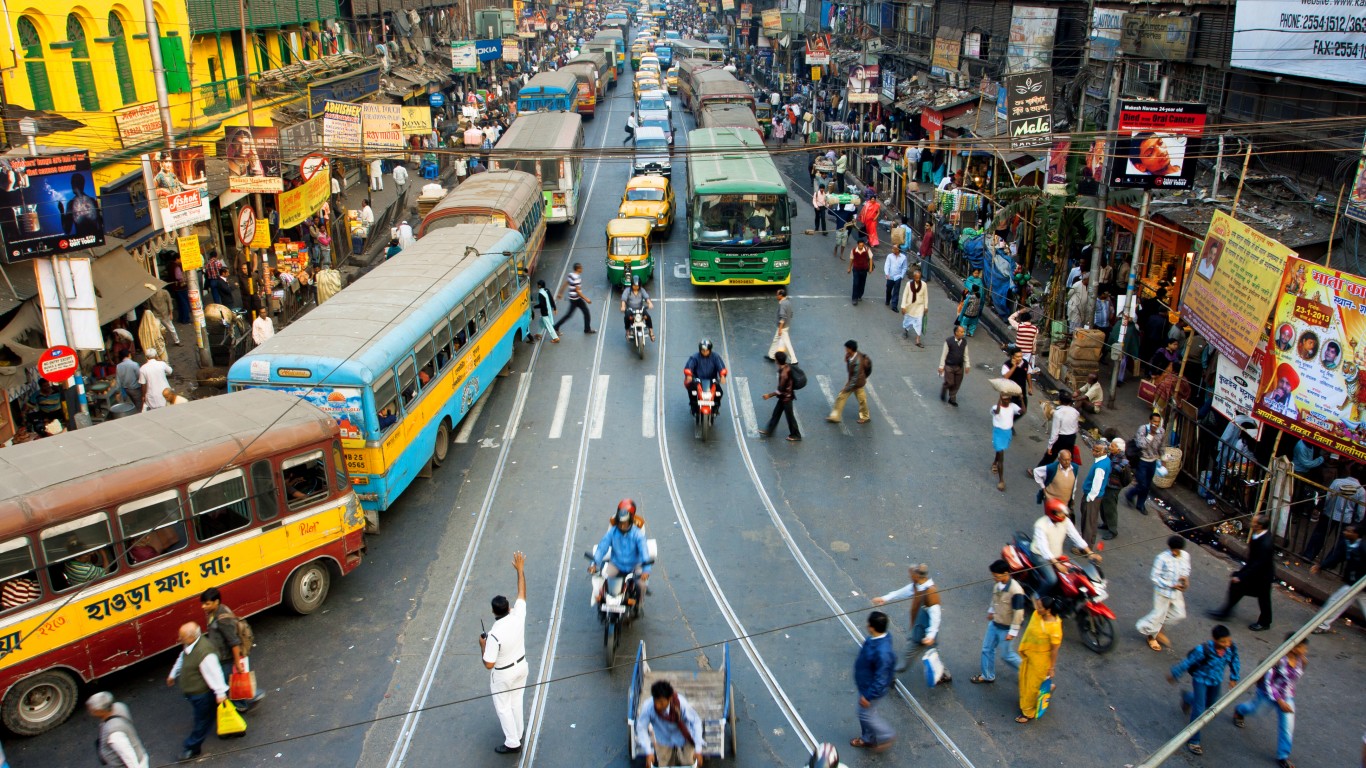
9. Kolkata, India
> Est. population, 2050: 23.4 million, 54% growth from 2022
> Ecological threat level: 3 – Medium
> Air quality: 3 – Unhealthy
> Expected climate changes: Drier
> Global peace index (1-5, most to least): 2.78 – Very Low Peace
> Estimated GDP in 2020: $224 billion
Kolkata, one of five Indian cities on this list, suffers from extremely high air pollution, with the smallest and most harmful particulate matter (emitted from vehicles, industrial activity, and burning wood and trash) nearly 12 times above what the World Health Organization considers healthy.
Situated on the Ganges River in east near Bangladesh, Kolkata is choked with traffic, densely populated with people living in poverty, and wreaked with air, water, and soil pollution. The city’s large leather tannery industry, a vital source of jobs, releases toxins into local waterways.

8. São Paulo, Brazil
> Est. population, 2050: 24.0 million, 7% growth from 2022
> Ecological threat level: 4 – High
> Air quality: 3 – Unhealthy
> Expected climate changes: Wetter
> Global peace index (1-5, most to least): 3.29 – Very Low Peace
> Estimated GDP in 2020: $411 billion
One of the world’s top five largest urban areas and South America’s largest city is wreaked with serious environmental issues in the areas of waste management, water quality, and emissions control. Like the other cities on this list, São Paulo is marked by overcrowded conditions and population growth that is outpacing development.
Climate change may cause the city to be “wetter,” but variable rainfall and continued rapid deforestation is causing more frequent droughts in this region of Brazil.
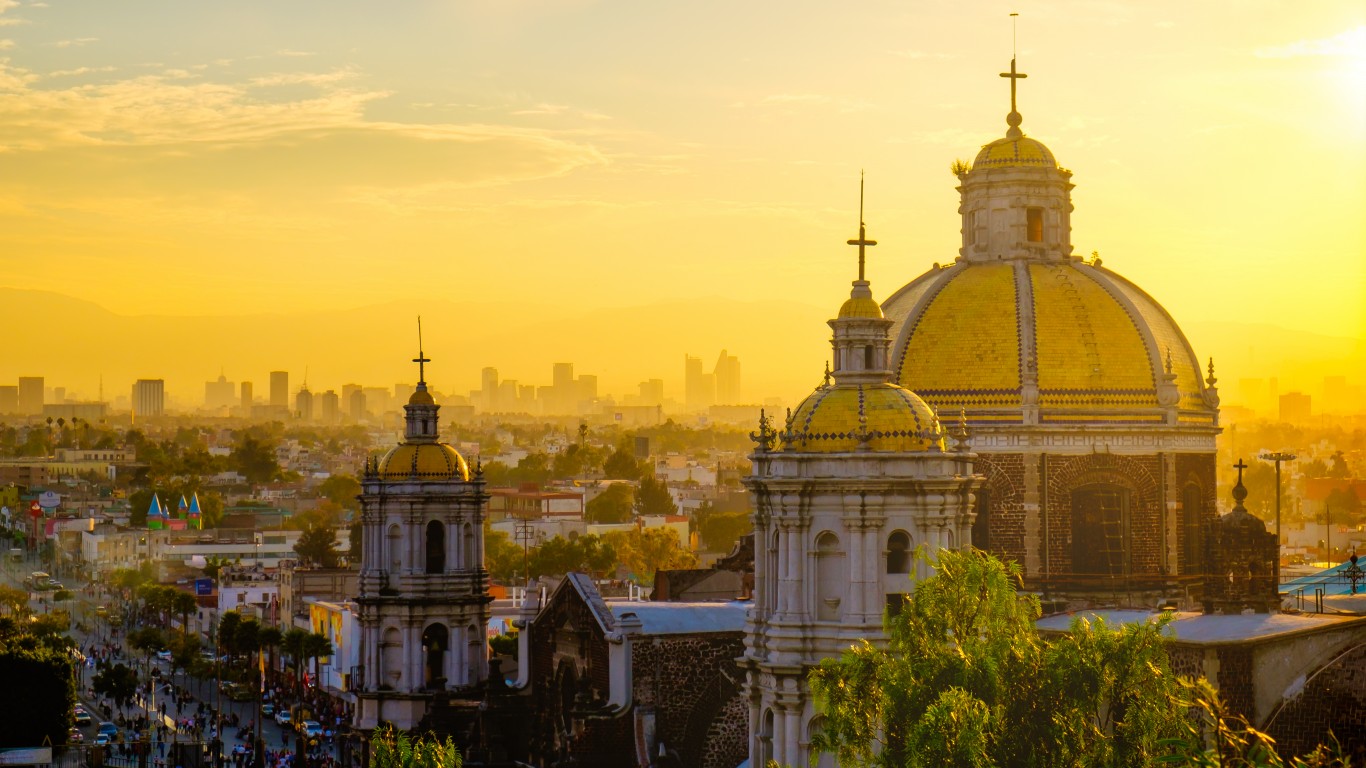
7. Mexico City, Mexico
> Est. population, 2050: 25.8 million, 16% growth from 2022
> Ecological threat level: 2 – Low
> Air quality: 3 – Unhealthy
> Expected climate changes: Colder, Drier
> Global peace index (1-5, most to least): 3.48 – Very Low Peace
> Estimated GDP in 2020: $608 billion
The largest city in North America by population is situated on a high plain ringed by mountains on three sides, which has long posed a distinct environmental threat from the city’s massive growth since the middle of the last century: cooler high-altitude air traps vehicular and industrial emissions close to the ground, especially during the city’s dry season in its winter months.
Water shortages are common and are expected to worsen as the city sucks up available reservoirs and the climate gets drier. According to the report, parts of Mexico City are sinking by 50 centimeters per annum.
[in-text-ad-2]
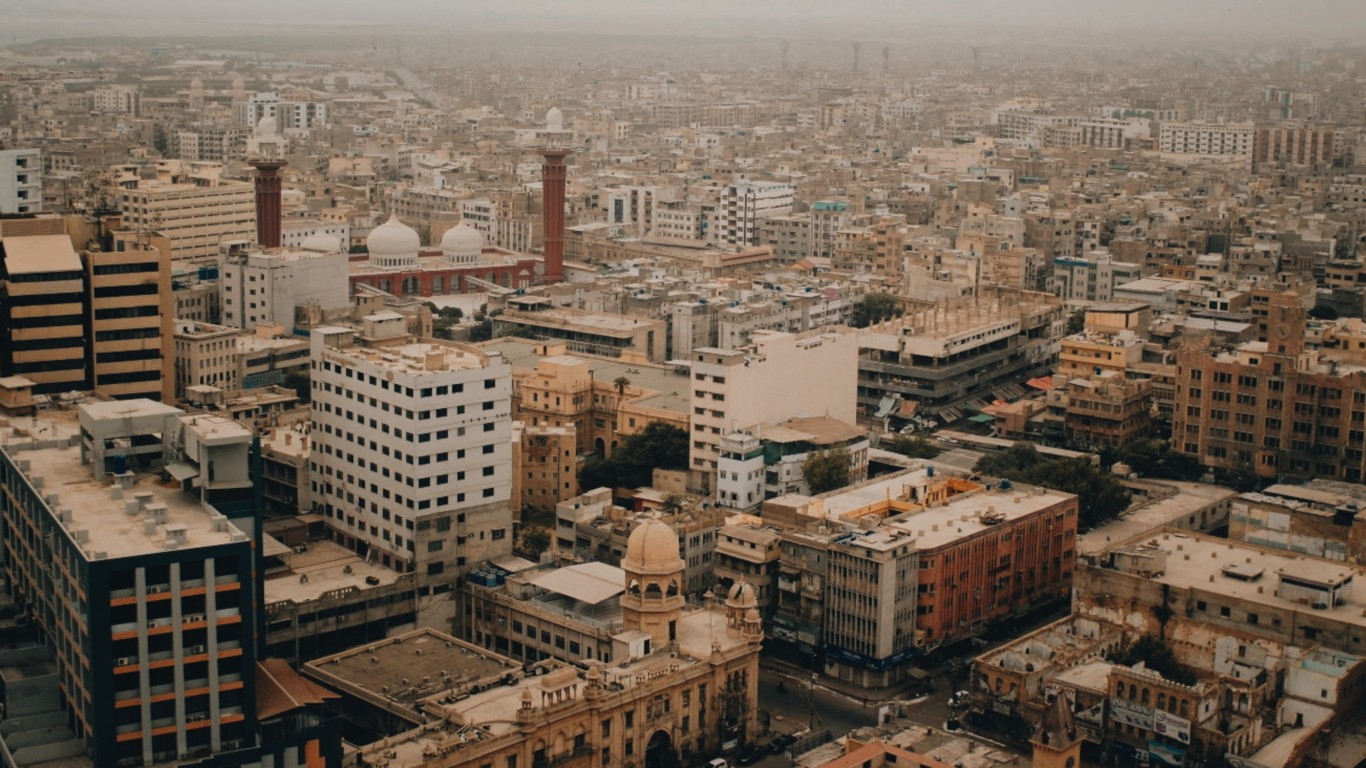
6. Karachi, Pakistan
> Est. population, 2050: 26.6 million, 57% growth from 2022
> Ecological threat level: 4 – High
> Air quality: 3 – Unhealthy
> Expected climate changes: Hotter, Wetter
> Global peace index (1-5, most to least): 3.05 – Very Low Peace
> Estimated GDP in 2020: $127 billion
Pakistan’s largest city by population has seen the number of residents grow rapidly since the creation of the country in 1947 – from about 450,000 to 17 million, including both city residents and people living within the larger urban area of Karachi. As with other cities on this list, this alarming expansion of population is outpacing the city’s ability to provide controlled management of housing and civic infrastructure related to waste management, drainage, water quality, and air quality.
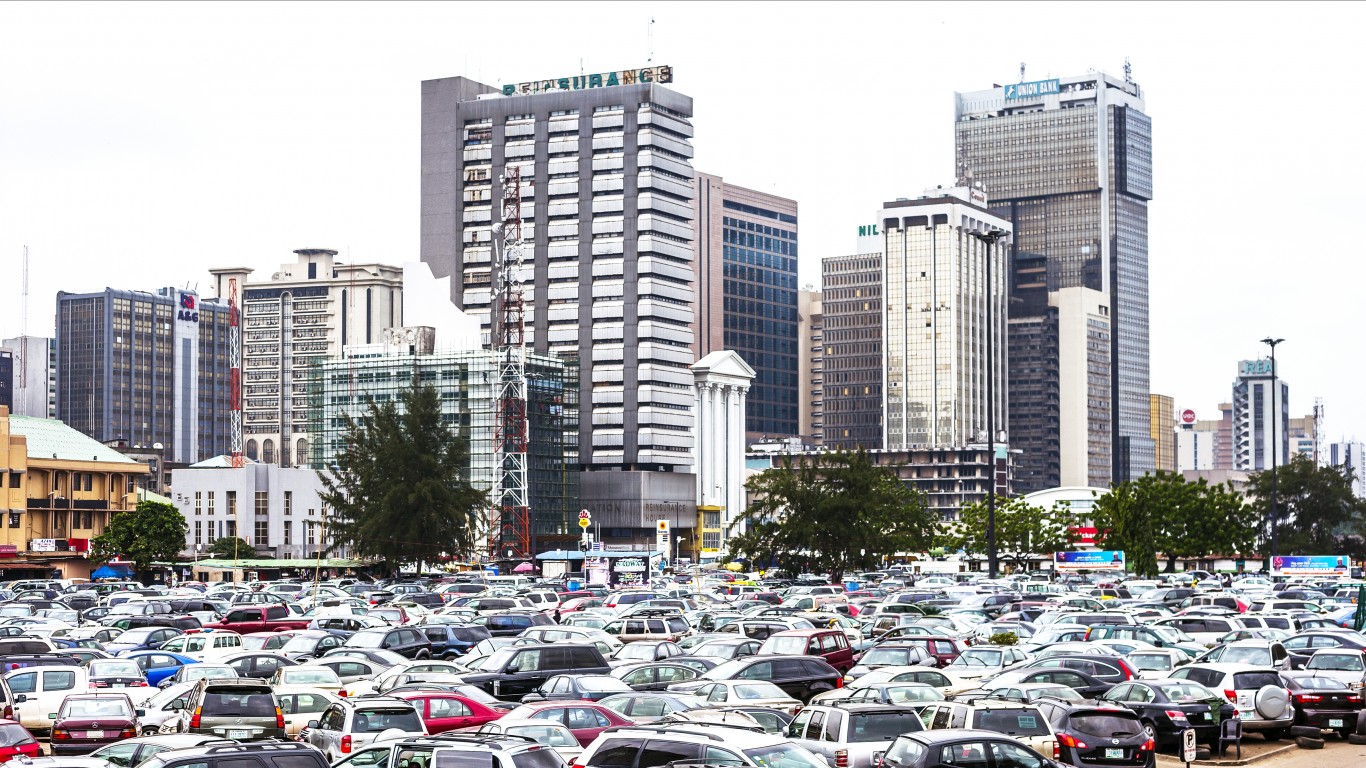
5. Lagos, Nigeria
> Est. population, 2050: 28.2 million, 82% growth from 2022
> Ecological threat level: 5 – Extremely High
> Air quality: 5 – Hazardous
> Expected climate changes: Hotter, Wetter
> Global peace index (1-5, most to least): 3.44 – Very Low Peace
> Estimated GDP in 2020: $76 billion
Africa’s most populated city produces about 10,000 tons of waste daily, of which only about 40% is collected and disposed of in a regulated manner. Air quality consistently exceeds international recommended limits, largely from the city’s massive number of unregulated vehicles and lack of efforts to control emissions effectively.
Unfettered industrial waste is a main cause of water pollution. Poor enforcement of dredging activities is damaging coastal ecosystems and damaging fisheries, an important source of localized economic activity and food.
[in-text-ad]
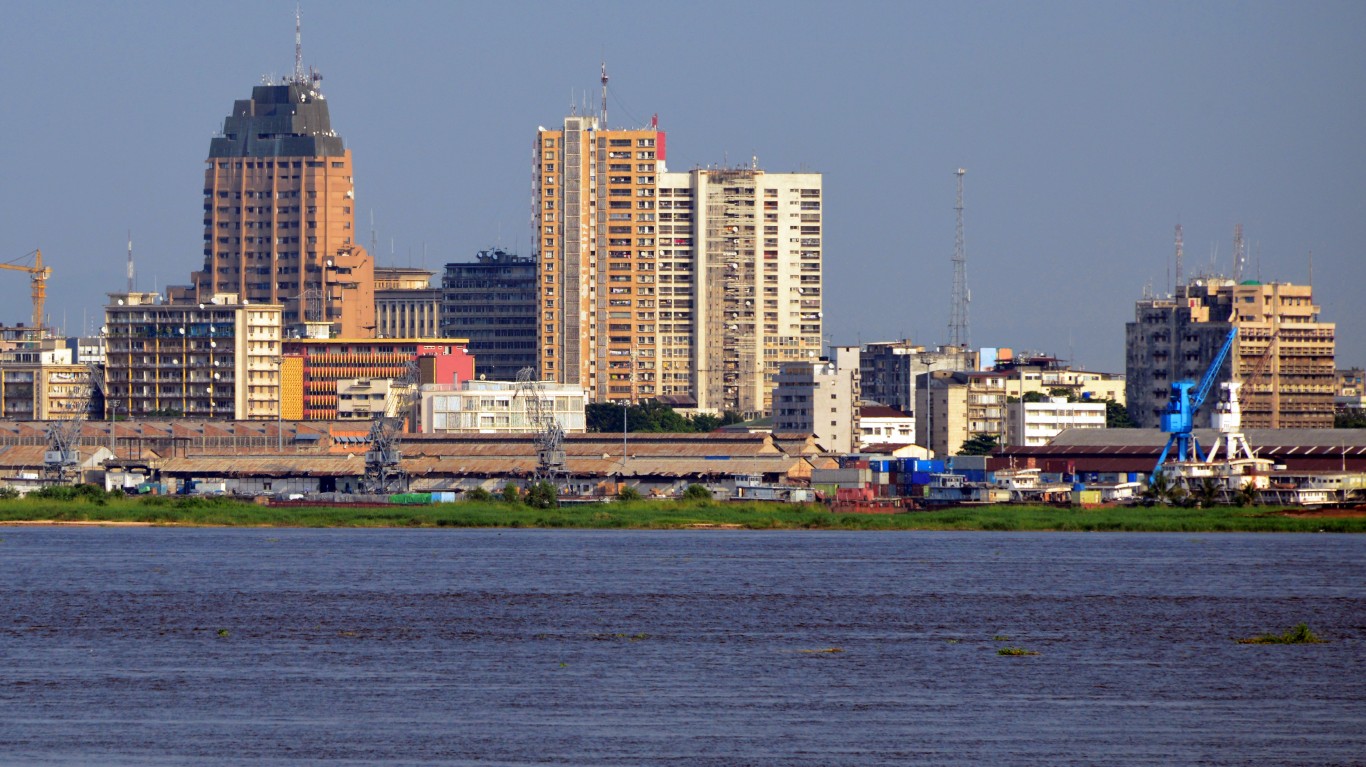
4. Kinshasa, Democratic Republic of the Congo
> Est. population, 2050: 29.0 million, 84% growth from 2022
> Ecological threat level: 5 – Extremely High
> Air quality: 2 – Unhealthy for Sensitive Groups
> Expected climate changes: Drier
> Global peace index (1-5, most to least): 3.95 – Very Low Peace
> Estimated GDP in 2020: $25 billion
Kinshasa is one of six large African cities on this list. The capital of the DRC and one of the continent’s most-populated cities lacks professional and regulated waste management for its nearly 15 million residents. The waste management problem has gotten worse since 2015, when the European Union ended an aid program to support better waste disposal.
Kinshasa, which transitioned from a fishing town into a huge metropolis of geostrategic importance due to the province’s mineral wealth, is projected to face increasing pressures from high population growth, specifically in water and food security. The country is likely to experience higher temperatures, more extreme weather events, and changes in total precipitation. The city’s massive traffic jams and vulnerability to both floods and droughts are other major ecological threats.

3. Mumbai, India
> Est. population, 2050: 32.4 million, 54% growth from 2022
> Ecological threat level: 4 – High
> Air quality: 3 – Unhealthy
> Expected climate changes: Hotter, Wetter
> Global peace index (1-5, most to least): 2.78 – Very Low Peace
> Estimated GDP in 2020: $300 billion
India’s second most populated city faces many of the same ecological threats as India’s other most-populated cities, Delhi and Kolkata, namely poor air quality from traffic, wood and waste fires, and construction activity.
Mumbai’s Powai reservoir, an artificial lake dating back to the British Raj, is so polluted it no longer serves its intended purpose of supplying drinking water. Coastal mangroves, which serve as a natural barrier to monsoon storm surges and help prevent soil erosion, are disappearing at an alarming rate.
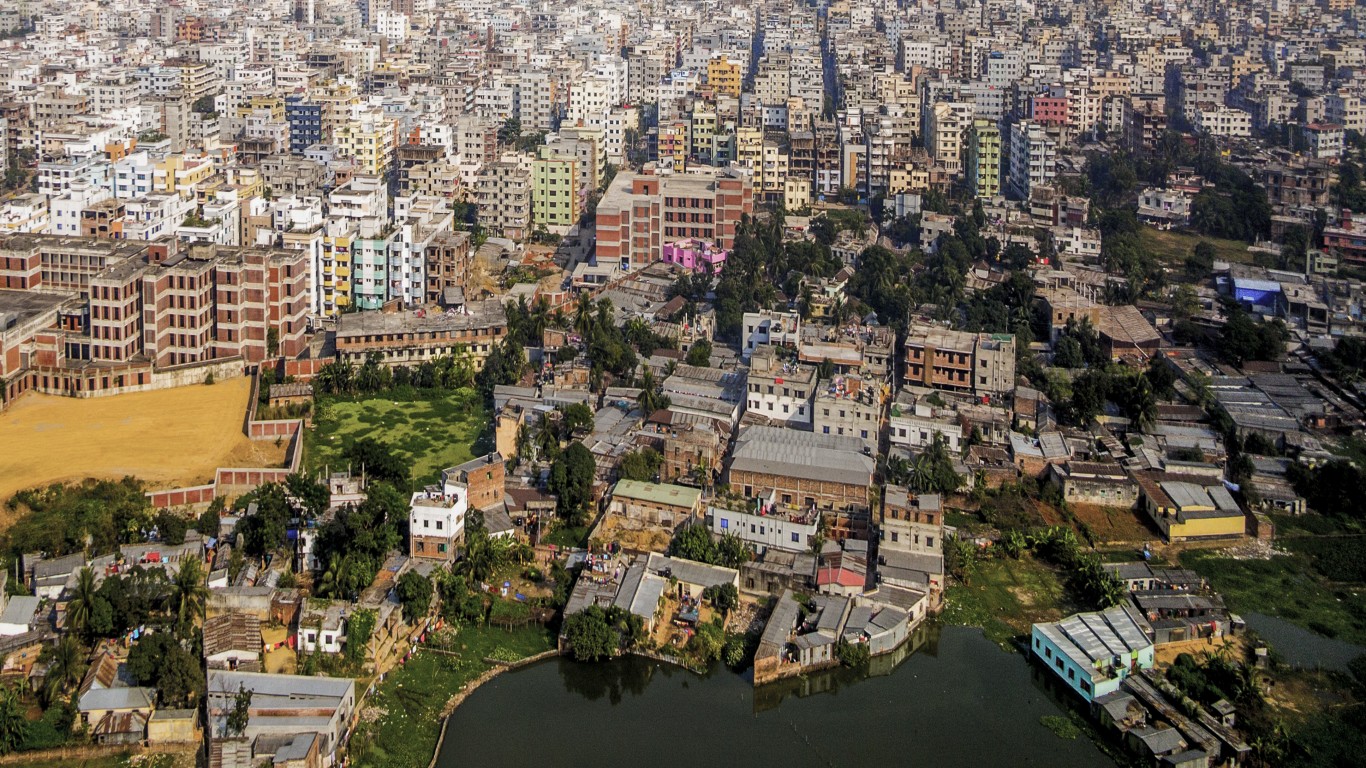
2. Dhaka, Bangladesh
> Est. population, 2050: 34.6 million, 53% growth from 2022
> Ecological threat level: 4 – High
> Air quality: 3 – Unhealthy
> Expected climate changes: Wetter
> Global peace index (1-5, most to least): 2.46 – Low Peace
> Estimated GDP in 2020: $126 billion
The capital of Bangladesh is so densely populated, underdeveloped, and close to sea level, that the ramifications of global warming will be felt by more people there than in most other large cities on the planet. A third of the city’s population cannot rely on piped water, and many residents end up in informal settlements and in the Korail slum.
Heavy vehicular traffic and uncontrolled emissions makes the city’s air quality consistently among the world’s worst. Toxins from unregulated landfills and waste disposal leak into neighboring communities and farms.
[in-text-ad-2]
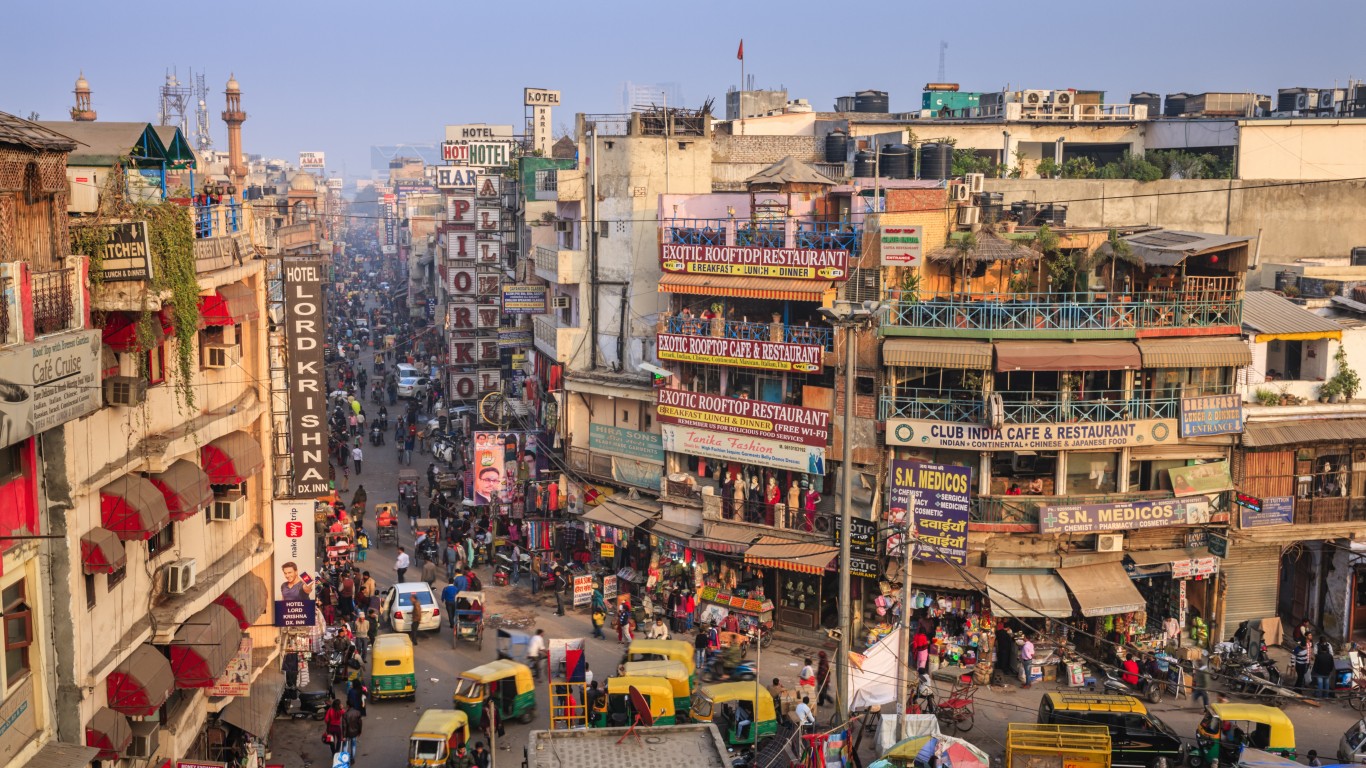
1. Delhi, India
> Est. population, 2050: 49.6 million, 54% growth from 2022
> Ecological threat level: 4 – High
> Air quality: 3 – Unhealthy
> Expected climate changes: Hotter
> Global peace index (1-5, most to least): 2.78 – Very Low Peace
> Estimated GDP in 2020: $229 billion
Delhi’s high incidence of cardiovascular damage among its population can be attributed to the toxic haze that covers the National Capital Territory that includes India’s capital of New Delhi. The levels of fine particulate matter emitted largely from vehicles, burning of wood and rubbish, diesel generators, and construction activity, far exceeds World Health Organization limits.
Several interrelated factors explain Delhi’s poor air quality, including pollutants from human activity (such as burning wood), construction, poor public transport system, and unfavorable geographic location and regional meteorology, which results in low humidity and episodic dust events from the surrounding environment.
Water pollution, potable water availability, and quality of waste disposals are other ecological threats in one the world’s largest and one of its fastest-growing cities.
Methodology
To find the megacities facing the greatest challenges in dealing with ecological threats, 24/7 Wall St. reviewed the global think tank Institute for Economics & Peace report Ecological Threat Report 2022. The report identified 20 cities, some already megacities (over 10 million population) and some will become megacities by 2050, with high population growth, low societal resilience, and substantial ecological threats. Several criteria were considered, including population growth, current coping abilities, number and intensity of ecological threats, ranking on the global peace index (GPI), and various measures of violence.
We added estimated gross domestic products for each city in 2020 in U.S. dollars from “The 150 richest cities in the world by GDP in 2020” published by City Mayors, an international research and campaigning think tank dedicated to urban affairs, maintained and financed by professionals in Europe, the Americas, and Asia.
Full citation: Institute for Economics & Peace. Ecological Threat Report 2022: Analysing Ecological Threats, Resilience & Peace, Sydney, October 2022. Available from: http://visionofhumanity.org/resources (accessed 15 Nov. 2022).
Thank you for reading! Have some feedback for us?
Contact the 24/7 Wall St. editorial team.

 24/7 Wall St.
24/7 Wall St.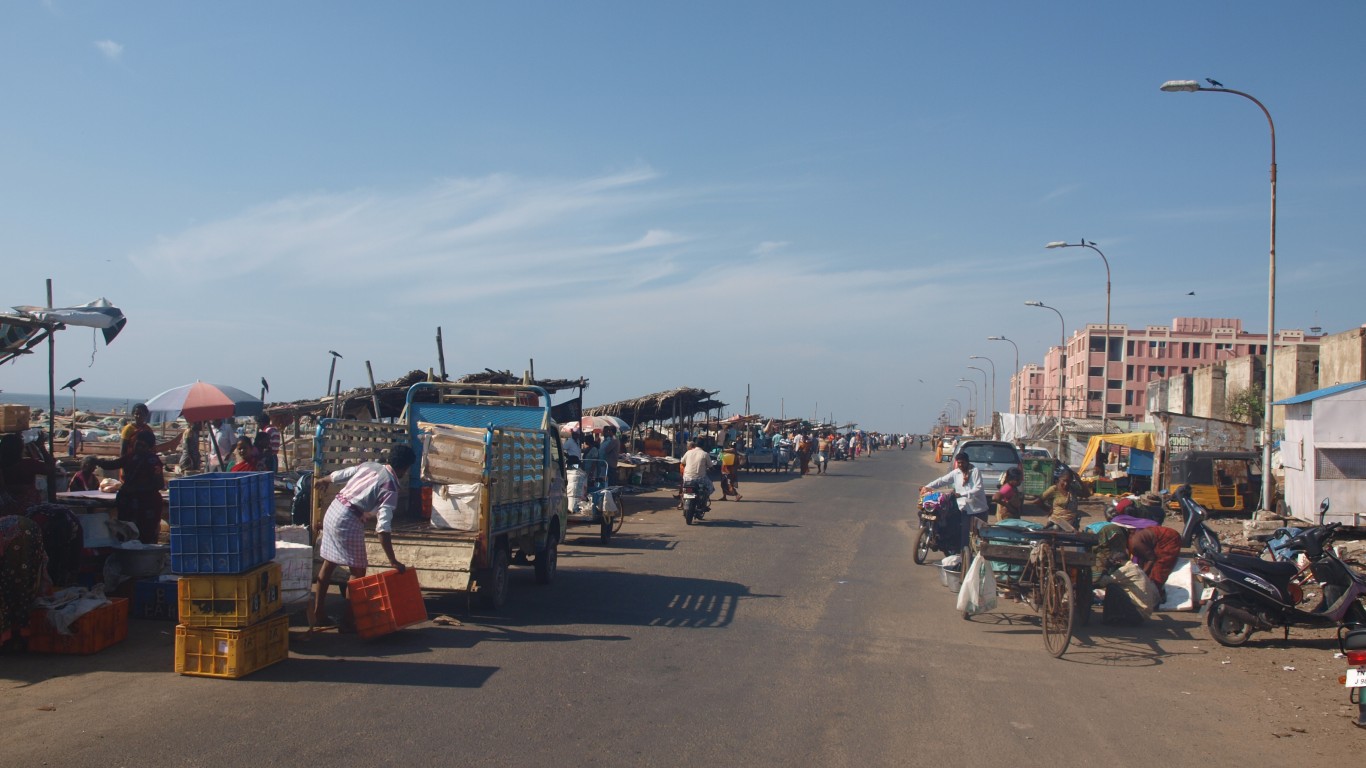
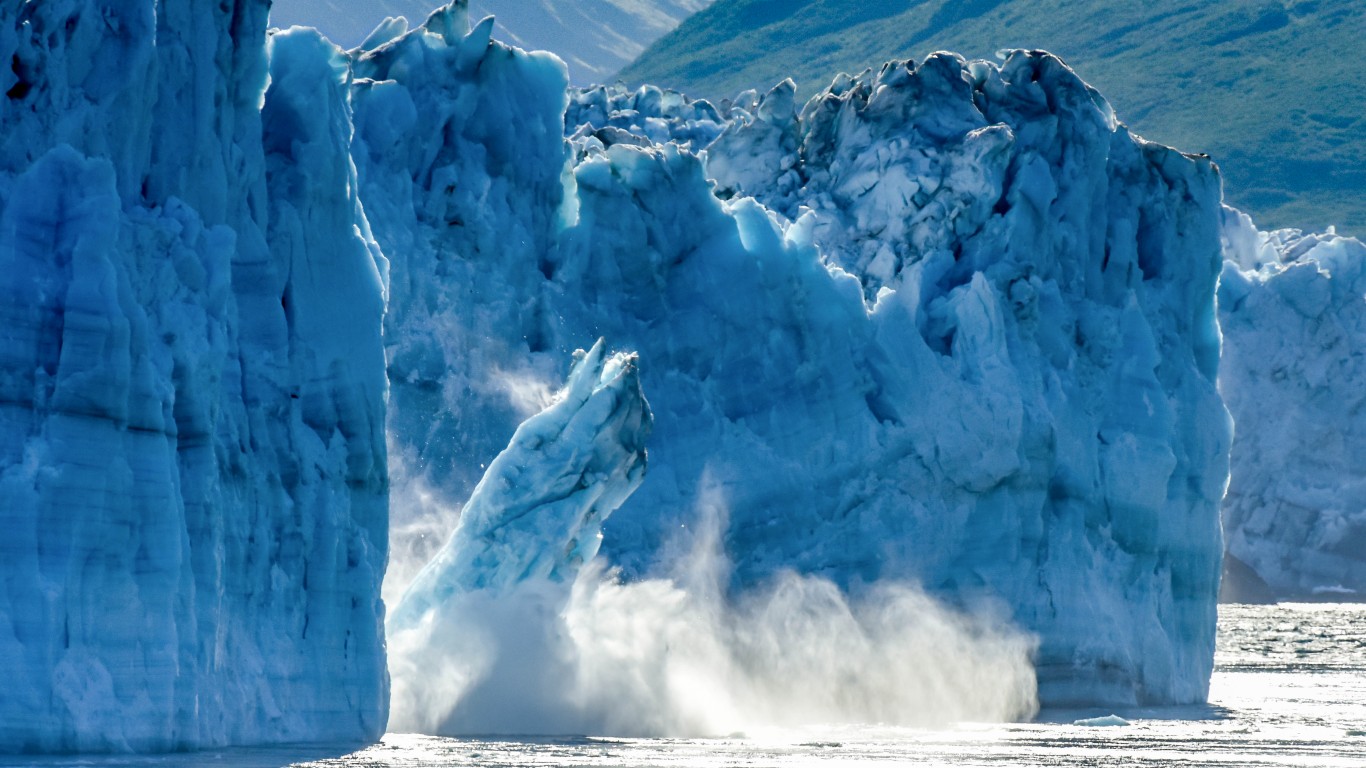 24/7 Wall St.
24/7 Wall St.